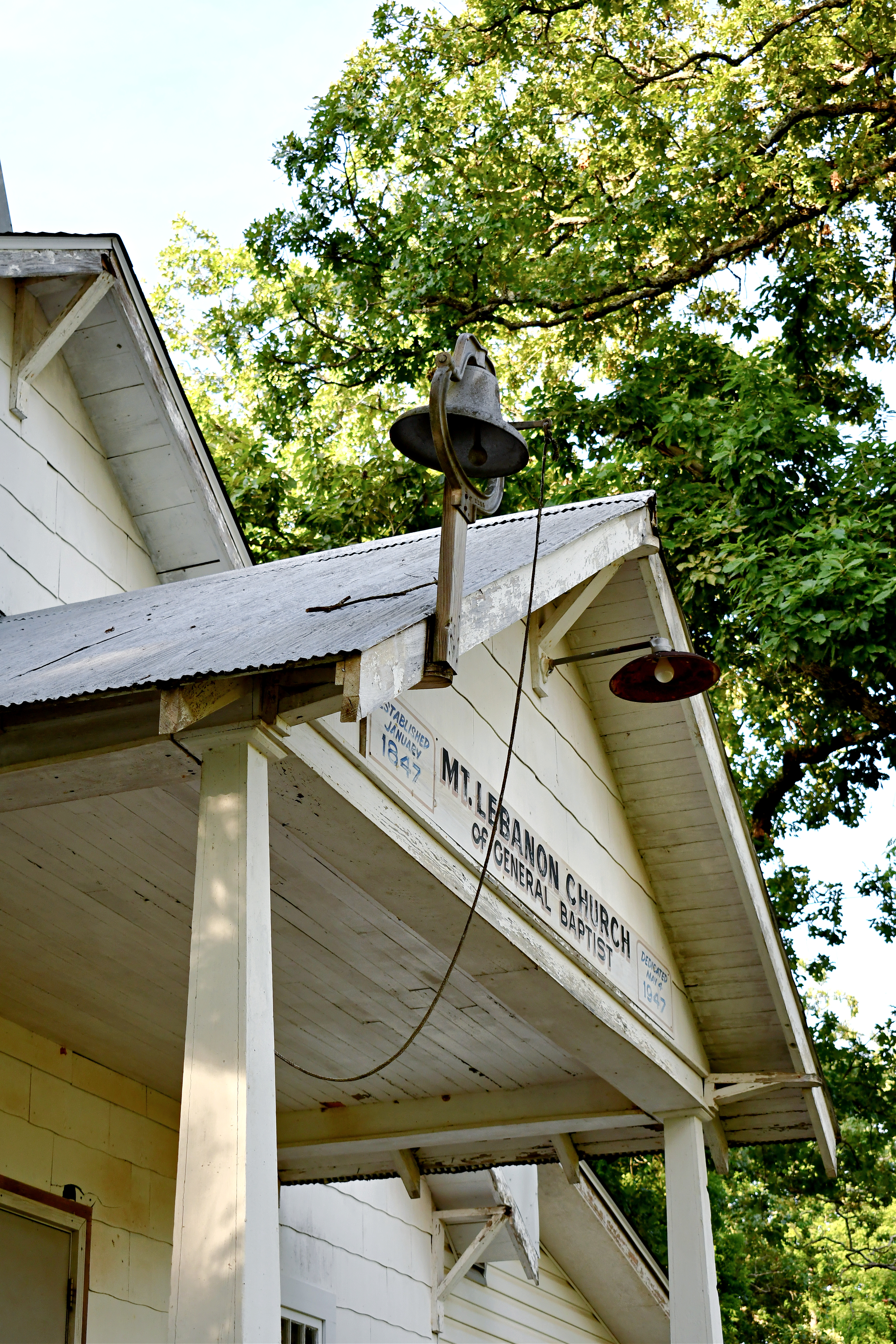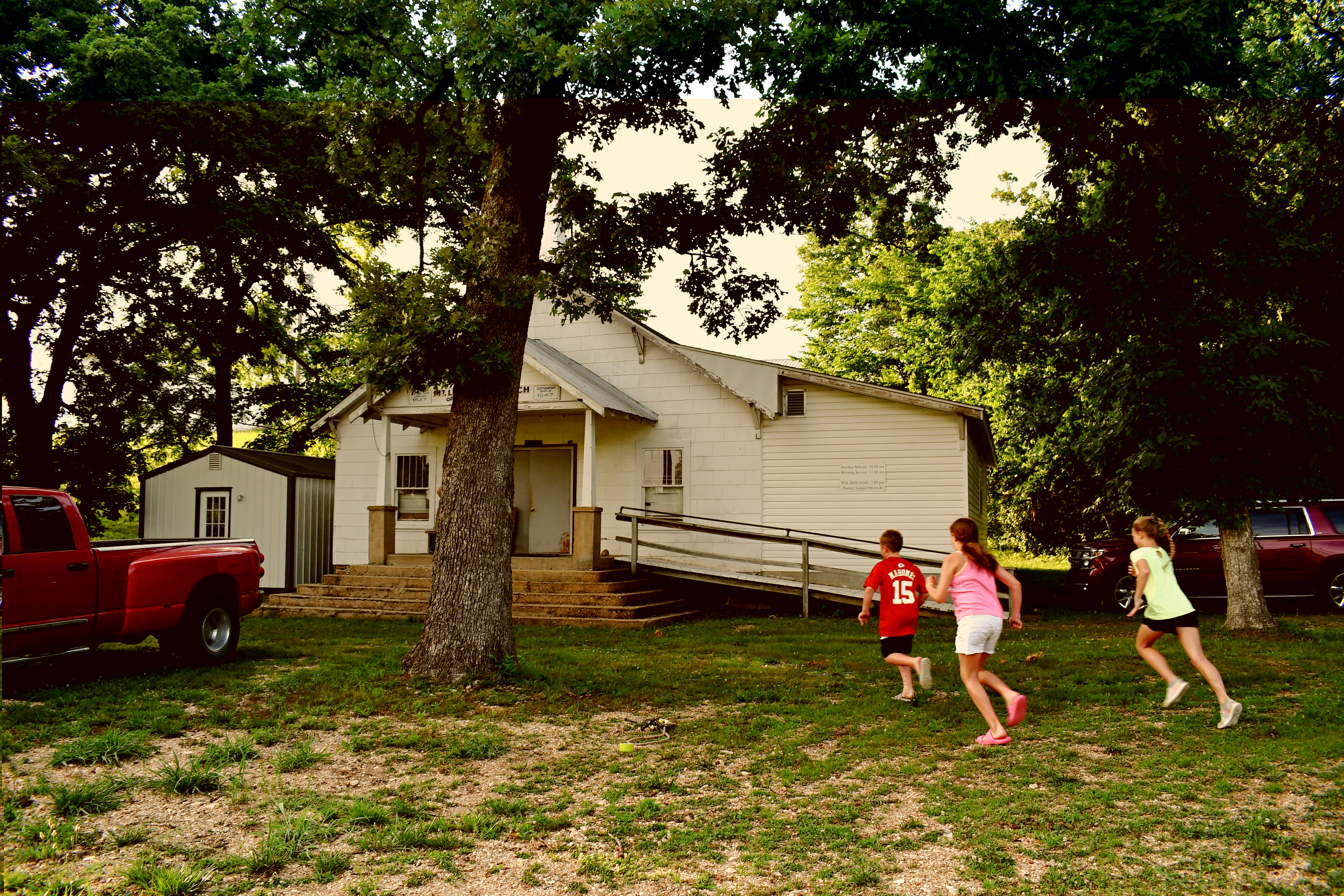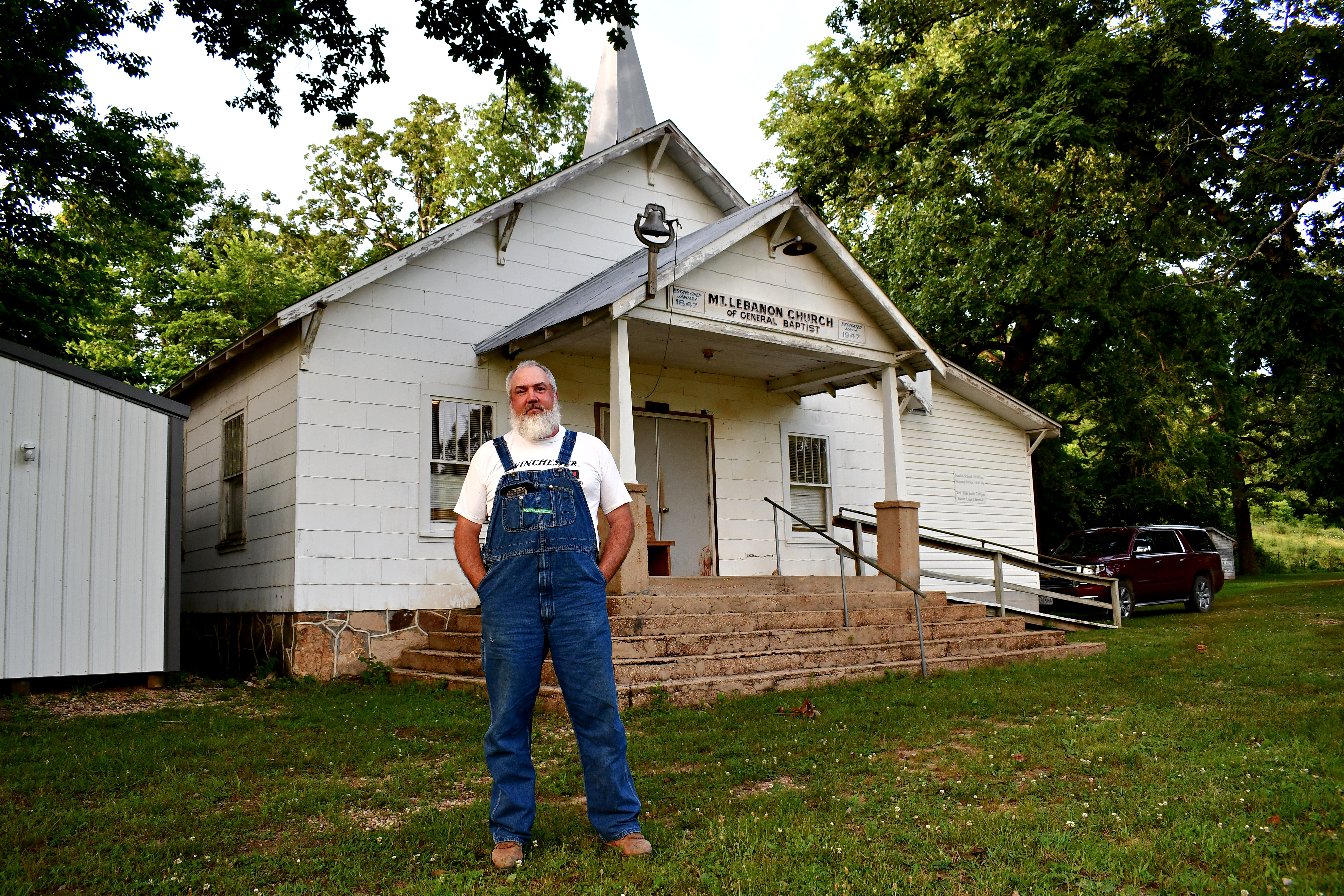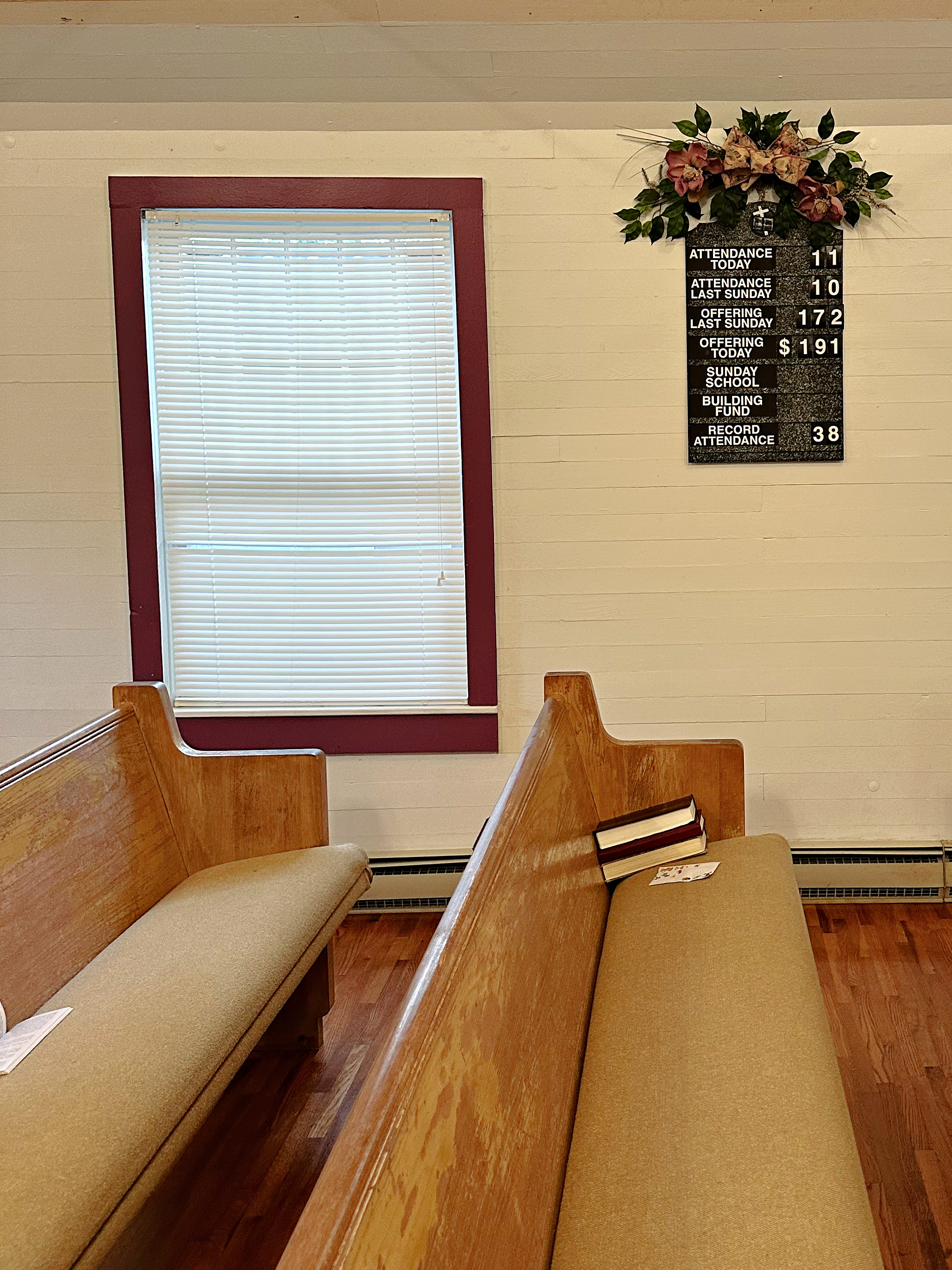This story is published in partnership with Ozarks Alive, a cultural preservation project led by Kaitlyn McConnell.

RURAL OZARK COUNTY — The gravel road twisted and turned before it showed me where I was going. It wasn’t the final destination that I saw, but a small white church that looked like it was from another time — especially when I saw the “Established January 1847” above the door.
It was a serene sight, like I was peering through a dusty, sun-dappled window into the past.
I wasn’t sure if the church is still active or not, but the big yellow bus nearby made me think it might be. And since it was Wednesday, I figured I’d drive back out later on and see if services were being held.
In the soft, sun-setting stillness, I motored back on blacktop to gravel and then to the church, where a smattering of cars took their drivers and passengers that quiet evening.
While all churches and people have stories to tell, I soon learned that there is more about this one than I realized at first glance.
“This church is the oldest General Baptist church west of the Mississippi,” Josh Mayberry, a deacon, told me after I arrived. “It was established in 1847, which makes it kind of unique. You know, that’s 176 years.”
General Baptist Ministries began in the 1820s. Today, the denomination exists primarily in the Midwest, although there are a number of churches in outlying states like Texas, Florida and California, as well as a few international locations. Its headquarters are in Poplar Bluff, Missouri, a community of about 16,000 people in the eastern Ozarks.
“God has blessed this church through the years. God’s still moving,” said Louis Stern Jr., who has pastored the church for about 20 years. “The problem I see is people are moving away from God too much. Too many distractions.”
A much different world
The tucked-away, longtime Ozark County congregation came to be because of a man named Thomas Norris, I learn, who immigrated to Missouri from North Carolina by way of Kentucky.
He was ordained in 1846, and that fall he and the family that he joined by marriage moved to Missouri. To add some historical context, that was 25 years after Missouri became a state and five years after Ozark County was founded, but still an undeveloped era for this part of the Ozarks in the years before the Civil War.
“They chose land in a wilderness area along Little North Fork River and one of its tributaries, Little Creek, in Ozark County. With a ready-made congregation, Bro. Norris continued to preach,” says “The Mt. Lebanon Story,” a book about the church’s history. It also notes the church was officially founded after a convention, attended by family members, was held in January 1847.

“They called the new church Mt. Lebanon honoring the Mt. Lebanon Church in Kentucky in which Norris had been converted.”
The first church was not where the congregation currently meets. That was a small log structure with a clapboard roof and a cemetery with mostly unmarked graves, the book shares. The congregation eventually outgrew the structure in the years following the Civil War.
“As the general population increased following the war, so did the membership of Mt. Lebanon, making it the largest and most prominent church in the area,” the book’s pages say.
The church ultimately helped start other congregations in the area and in 1866 led the start of an association. Today, that group meets annually at the Piland Youth Camp, an entity independent from Mt. Lebanon but located just up the hill from its fourth and current home.
The church where folks now gather was built in the mid-1940s after the previous one — which doubled as the local schoolhouse and was built with lumber milled at nearby Rockbridge — didn’t fit the needs of the church any longer.
“Many families had moved away during the Great Depression of the '30s and during World War II to find work elsewhere, thus greatly diminishing the membership,” notes the church’s history book. “The old pine building had greatly deteriorated, the road had been moved east a quarter of a mile away from the creek and the church, and Mt. Lebanon’s centennial anniversary was coming up.”
A monument to that moment stands near the “new” church that still serves after nearly 80 years.
Visiting Mt. Lebanon

A bell’s toll from the porch called three adults to Bible study in a small building next to the church, while a handful of children and youth ran to the sanctuary.
“God has blessed the church; He really has,” said Stern. “We had to go buy an extra building for a study hall. That’s a whole story in itself, because those things aren’t cheap.”
The building was added when there were a few more people in their ranks. Time has taken some away, but may bring others back again. None of the members present on this particular Wednesday evening have lifelong connections with the church, but instead felt called to come here at different times.

“Where I was, I wasn’t the pastor. I just drove the bus and taught Sunday School,” said Stern, a mason by trade who moved to the area from Georgia with his wife, Margie, in the late '90s. “After we came here, I still wasn’t ordained, or a minister or nothing. But … the Lord just really called me to be ordained.”
He spoke with his pastor at the time, who directed him through the process of being ordained through the General Baptist denomination. The process involved meeting with the Missouri association of churches — comprised mainly of congregations in neighboring Ozark and Douglas counties — being licensed for a year, coming back for questioning, preaching at local churches and then receiving ordination. After he completed the process and the previous pastor left the church, Stern took over the pulpit.
“It’s unheard of, in today’s age and time we live in, for a preacher to be in a church for 20-some years, especially in a small rural church,” he said. “My answer is always the same: God hasn’t led me anywhere else. Now, the day He says go somewhere else, I’ll be somewhere else. But it doesn’t matter how big the flock is. They still need to be fed, whether it’s a half-dozen or a thousand.”

Generational Ozark County residents, the Mayberrys came to the congregation a few years ago after coming to a multi-church prayer meeting held because of a drought.
“At the time, they were having a community prayer meeting (for rain),” said Josh Mayberry. After the introduction, the couple made the move after feeling led to do so a couple of years later.
“We knew we were supposed to be here,” said Samantha Mayberry.
Meetings continue
Bibles open on the table, the Sterns and Josh Mayberry begin the evening with prayer requests. With bowed heads and hearts, the church’s pastor prays for those in need.
“We give you all the praise and all the glory. Please guide us tonight,” Stern said, and after amen, transitioned into 1 Corinthians 4:1.
Meanwhile, the youth lesson moved outdoors where Samantha Mayberry lead a lesson on the parable of the great banquet.

In the New Testament story, Jesus shares about a man who planned a banquet to which none of his friends chose to come. As a result, he opened it to everyone: “Then the master told his servant, ‘Go out to the roads and country lanes and compel them to come in, so that my house will be full. I tell you, not one of those who were invited will get a taste of my banquet.’”
At the end of the story — and after creating a symbolic banquet setting out of old newspapers — a call for salvation completed the evening. That decision is a fundamental element of the General Baptists’ 10 core beliefs.
“We believe that salvation (regeneration, sanctification, justification and redemption) has been provided for all mankind through the redemptive work (life, death, resurrection, ascension, and intercession) of Jesus Christ, and that this salvation can be received only through repentance toward God and faith toward our Lord Jesus Christ,” its website says.
And when folks get saved, they take the big yellow bus next to the church to the river for baptism, the next step in the redemption process.
“We usually use it to go Christmas caroling. That’s one of our big things,” said Stern. “Or baptism, because our baptism is in the creek down here. So we all pile in the bus and go down and have a baptism.”
While the congregants may believe that their hope is steadfast, the church isn’t immune to the changing world. Mt. Lebanon’s attendance has dropped from its Sunday morning high of 38 and its average attendance of 25, and now is in the teens. Sunday evening services have faded into the past.
“That’s why there’s a blank spot on the sign,” said Stern. “I scratched it off.”
But they also voice a commitment to keep going.
“God didn’t say to pack up and close the doors,” said Stern. “It’s not about us. It’s about being faithful.”
Mt. Lebanon General Baptist Church is located at 2325 State Highway D, Thornfield. Sunday School is held at 10 a.m., and service at 11 a.m. On Wednesdays, Bible study begins at 7 p.m.

